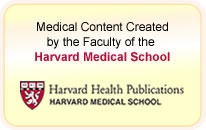
Conditions in Depth
This page contains the basic information about Gastroesophageal Reflux Disease (GERD) .
Return to the Gastroesophageal Reflux Disease (GERD) Main Condition Center
What Is It?
Gastroesophageal reflux disease (GERD) is a digestive disorder. It involves the esophagus, the tube that carries food from your mouth to your stomach.
In GERD, acid and digestive enzymes from the stomach flow backwards into the esophagus. This backward flow of stomach juices is called "reflux". These caustic stomach juices inflame the lining of the esophagus. This causes heartburn and other symptoms. If GERD is not treated, it can permanently damage the esophagus.
A muscular ring seals the esophagus from the stomach. This ring is called the esophageal sphincter. Normally, the sphincter opens when you swallow, allowing food into your stomach. The rest of the time, it squeezes tight to prevent food and acid in the stomach from backing up into the esophagus.
In most people with GERD, however, the esophageal sphincter does not seal tightly. It remains relaxed between swallows. This allows digestive juices to enter the esophagus and irritate the esophageal lining.
Many things can weaken or loosen the lower esophageal sphincter. These include:
-
Certain foods
-
Smoking
-
Alcohol
-
Pregnancy
-
Many medications
-
Increased abdominal pressure, because of obesity or pregnancy
-
A bulge in the stomach (hiatal hernia) that protrudes above the diaphragm
Prolonged exposure to acid can cause the esophagus to:
-
Become inflamed
-
Narrow
-
Develop an open sore
Long-term exposure to acid also can lead to a condition called Barrett's esophagus. Barrett's esophagus increases the risk of esophageal cancer.
For many people with GERD, heartburn is not merely an occasional discomfort. Rather, it is a frequent, even daily, ordeal.
From Health A-Z, Harvard Health Publications. Copyright 2006 by the President and Fellows of Harvard College. All rights reserved. Written permission is required to reproduce, in any manner, in whole or in part, the material contained herein. To make a reprint request, contact Harvard Health Publications. Used with permission of StayWell.